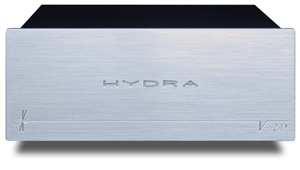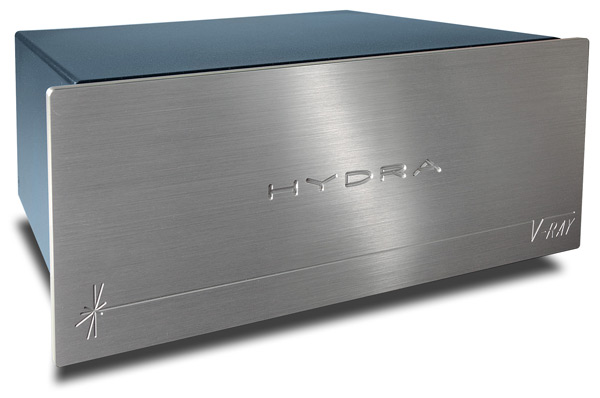![[SoundStage!]](../titles/sslogo3.gif) Home
Audio Home
Audio Equipment Review |
|||||
From his very beginnings in high-end audio, Caelin Gabriel, the founder of Shunyata Research, has created products that stand apart from the competition. Some of his power cords, for instance, are almost as thick as your wrist, and they are filled with a noise-killing compound that makes a distinctive sound when the cords are moved. None of this is for show, as his power cords have become an industry reference. I am on record saying that the Anaconda Vx and Alpha are the very best power cords I've used. The Python Vx and Alpha are close on their heels and cost half as much. None of Caelin's products is more distinctive than his original Hydra, which drew attention as soon as people saw it. The Hydra's outer case was a sight to behold -- all Corian, polished granite and lacquered-wood accents. The Hydra topped out at $2495 before it was discontinued, and it is still in demand on the used market. Its look practically screamed "hard to manufacture," and I'm sure the cosmetics added greatly to the unit's final cost. When Gabriel redesigned the Hydra and released it as the Hydra Model-8, he added two outlets and lowered its price. Both of these enhancements were byproducts of the unit's new, more conventional case. No matter the reason behind it, the Model-8, which now, nearly four years after its release, costs $2495, was a rousing sonic success. Shunyata spun off the Model-8's technology into lower-priced units with fewer outlets, which kept the company's downmarket trend going. I reviewed and purchased a Hydra Model-8 (I also owned the original Hydra) back in 2003, and I've used it happily since. It has become a fixture in my system. I rely on its "characteristic clarity" to help me figure out what I'm hearing from the products I review. When a manufacturer visited last year and insisted on removing it, preferring to use his company's products au naturel, I obliged. After he left, I put it back in and noted immediate sonic gains. While theories about audio gear abound, I'm more than happy to let my ears lead the way, and with the Hydra Model-8, using it is all lagniappe, as they say down South, a gift to audiophiles and especially audio reviewers. With all this in mind, when I began to hear rumblings about a new Shunyata power conditioner above the Hydra Model-8, I was vexed. What had Caelin Gabriel wrought with this new product, subsequently named the V-Ray? How different would it be from the Model-8, and what strange new technology would Gabriel have developed for it? The guys at Audio Research were among the first people outside Shunyata Research to hear this new bonbon, and all they would say to me was "Get a V-Ray."
Well, given that you've already seen the pictures, you know the Hydra V-Ray uses the same chassis and faceplate stock as the Hydra Model-8. It also has the same number of outlets -- eight in two groups for analog and digital gear. In reality there is nothing different about the digital and analog outlets of the V-Ray or Model-8, so you can mix and match the components you plug into them, though you do need to keep digital and analog products grouped together per duplex outlet. Why did Shunyata use the same chassis for the Hydra V-Ray as the Hydra Model-8? I asked this to Grant Samuelsen, Shunyata's marketing director. "Cost" was his answer. A new chassis would have added design and manufacturing cost to the finished V-Ray and raised its price even higher than $3995. While some of us had visions of the original Hydra's return, none would have liked paying an extra $1000 for it. Given that the V-Ray would fit into the Hydra's case, why not double dip, especially if doing so lowers the cost of your product and makes it more competitive? Perception, for one. Because the Model-8 and V-Ray look alike, some will think there is nothing different about them. The changes are, of course, inside, and they include a new copper bus system and redesigned filter networks. The bus system, which is the backbone of the V-Ray, has been redesigned and retooled, improving its ability to distribute power to the outlets. The Venom filters used in the V-Ray are larger than those in the Hydra Model-8 and there are triple the number of them: 36 versus 12. The V-Ray includes the Hydra Model-8's Trident Defense System to address power surges, power spikes and over-current episodes. Grant Samuelsen calls the V-Ray "a turbo version of the Model-8," which is a nod to the fact that the two units look alike on the outside, but the changes under the hood are what separate one from the other. And just as you would notice that your car suddenly had 20% more horsepower, you will hear the difference the V-Ray makes as soon as you put it in your system, even if you own a Hydra Model-8. The increased liquidity and transient speed give the music a smoother and more defined character at the same time. Voices are more supple, while drums and brass are more explosive, with a quicker attack. The perspective the Hydra Model-8 helps bring to the music is a little laid-back compared to V-Ray's more immediate midhall viewpoint. One of the uncommon things about the Hydra Model-8 is the ability to use it with all types of equipment, including high-power, high-current amps. The same is true of the V-Ray. The effects I note above were consistent with different amps, but their intensity varied, proving to me that the V-Ray was merely letting the amps sound more like they would with perfect power. The Lamm ML2.1 wasn't turned into a Conrad-Johnson Premier 350, or vice versa, but both sounded more fluid and nimble with every piece of music I played. Atma-Sphere MA-2 Mk III monoblocks draw a whopping 800 watts each, and they sound their best powered from the V-Ray and not straight from the wall. While Shunyata Research makes exceptional interconnects and speaker cables, it is still known as "a power company" because of its high-profile cords and conditioners. When I wrote about the Python Helix and Anaconda Helix power cords, I talked about how to use both in order to maximize sonic outcome and minimize cost. With the inclusion of the Hydra Model-8 and V-Ray into the mix, this becomes a much more involved exercise. Can you reach the V-Ray's performance with some combination of Shunyata power cords and the Hydra Model-8? I suppose this could be possible, especially if you stack the deck against the V-Ray and use it with a thin molded power cord to the wall. To my ears, however, the V-Ray is the Shunyata Research product that has the greatest sonic impact. I estimated the difference between the Anaconda Helix and Python Helix power cords to be about 20% in the Anaconda's favor. The gulf is even wider between the Hydra Model-8 and V-Ray. With the latter and, say, a Python Helix Alpha power cord to the wall, you'll have a state-of-the-art system for distributing and cleaning power that also protects your electronics. This is the sort of double duty that so many power conditioners can't perform. The line between sonically "different" and "better" is not always easy to is identify, especially with two products from the same company. Yet, the Shunyata Research Hydra V-Ray is clearly better than the Hydra Model-8. With his "turbo" V-Ray, Caelin Gabriel has made another distinctive product, and one that makes a strong case for being the standard in power conditioning here and now. ...Marc Mickelson
|
|||||
|
|||||
![[SoundStage!]](../titles/sslogo3.gif) All
Contents All
ContentsCopyright © 2007 SoundStage! All Rights Reserved |


